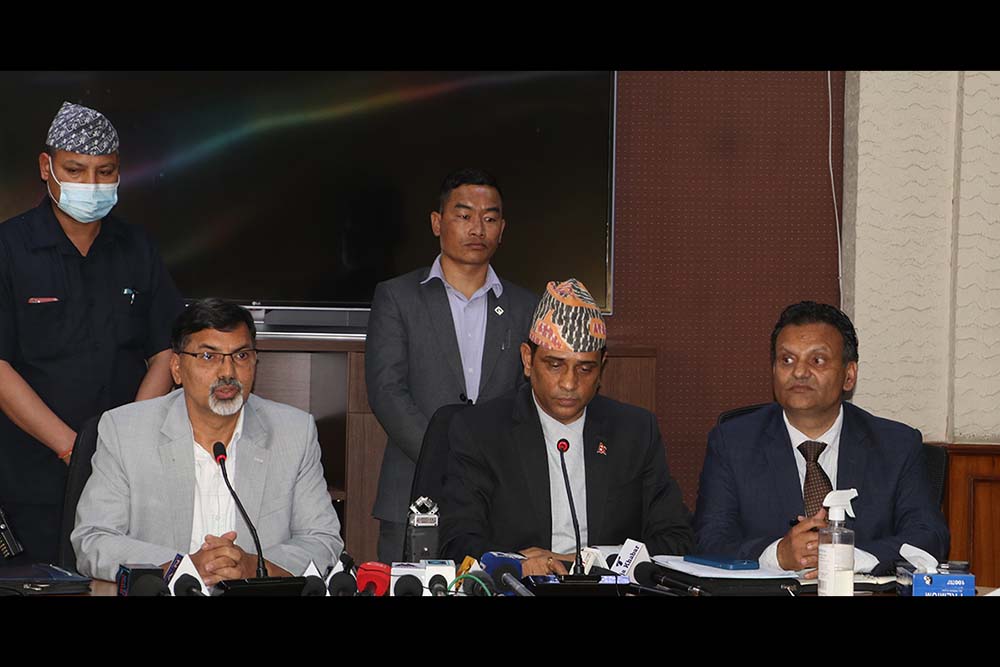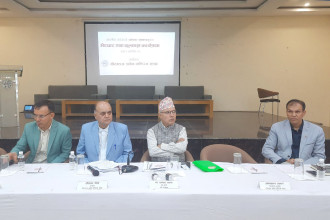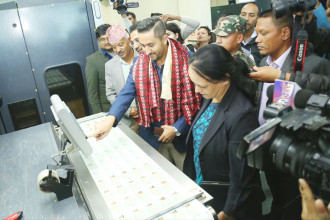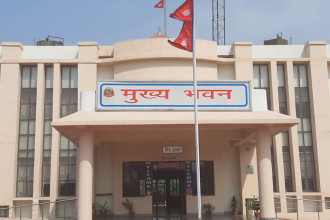
The media reports expressing interest and concern over the current economic situation in the country have drawn the attention of the Ministry of Finance. A statement issued by the ministry on Monday expressed the hope that this kind of support would help the ministry to take appropriate tactical steps by conducting regular analyses of the economy.
The Finance Ministry has informed that it is regularly analysing the current state of the economy and taking measures to implement various policies and programmes.
The statement said the aggregate indicators of the economy remain modest. However, due to some pressure on the external sector, some policy measures have been taken to boost import management and foreign exchange reserves, the ministry clarified.
To inform the general public and stakeholders about the current state of the economy, the ministry presented the status of the indicators for the current Fiscal Year.
Economic growth and gross domestic product (GDP) In fiscal year 2020/21, economic growth turned negative by 2.1%, but in FY 2021/22, due to the adverse effects of the second wave of Covid 19 pandemic, the economy failed to achieve the target of 7% and was limited to 4%. As compared to February/March 2020, about 98% of industries and businesses came into operation by October/November 2022, and the service sector gradually improved. This is likely to have a positive impact on economic growth.
Price The average inflation during the first eight months of the current fiscal year has been 5.4% in comparison to the inflation of 5.18% in the last three years. Due to the recent price hike of crude oil in the world market, which has a direct impact on the overall price level of Nepal, additional measures need to be taken to keep consumer inflation within the desired range, the statement said.
Foreign trade The high growth in imports has led to an increase in trade deficit, putting pressure on the economy. Commodity imports and exports amounted to Rs 1450.71 billion and Rs 159.76 billion respectively until April 8 of the current fiscal year 2021/22. This means imports and exports increased by 33.9% and 72.8% respectively over the corresponding period of the previous fiscal year. As a result, trade deficit has increased to Rs. 1290.96 billion, said the Finance Ministry. The rise in global petroleum prices has added to the trade deficit, the ministry added.
Foreign exchange reserves By mid-July 2021, foreign exchange reserves of Rs 1399.03 decreased by 17.2% and remained at Rs 1171 billion by mid-March 2022. The reserves seem to be sufficient to support the import of goods and services for about 6.7 months, the statement read.
Remittance inflow By mid-March of the current fiscal year, remittance inflows decreased by 4.9% to Rs 631.19 billion compared to the same period in the previous fiscal year. Meanwhile, remittance inflow has reached Rs 91 billion from mid-February to mid-March, 2022. This indicates that remittance inflows are increasing.
Foreign employment By mid-March of the current fiscal year, the number of Nepalis receiving work permits (institutional, new individual and legalised) for foreign employment has increased significantly by 363% to 226,700. In the same period in the previous fiscal year, the number of people receiving work permits had decreased by 74.8%. Likewise, the number of Nepalis seeking re-employment has increased by 192% to 178,262. The number of foreign job aspirants seeking re-employment abroad had decreased by 65.2% in the corresponding period of the previous fiscal year.
Foreign investment As of mid-March of the current Fiscal Year, a commitment of Rs 33.38 billion has been received. The amount is an increase of 31.3% in comparison to the previous fiscal year. By mid-February 2022, foreign investment of Rs 82.47 billion has been approved by the Investment Board, Nepal.
Public expenditure In the current fiscal year, the total expenditure of the federal government until April 9 was Rs 768.25 billion which is 47.05% of the total allocation. Such expenditure was Rs 672.78 billion (45.62% of the total allocation) in the corresponding period of the previous year. Overall, the expenditure in the current fiscal year is 14.2% more than the previous fiscal year during the same period of time. Out of the total expenditure, current expenditure is Rs 605.63 billion or 56.85% of the allocation while capital expenditure is Rs 97.66 billion or 25.83% of the allocation. Similarly, expenditure under financial management stood at Rs 64.97 billion or 34.29%. In the corresponding period of the previous fiscal year, recurrent expenditure was 54.38% of the allocation, capital expenditure was 28.08% and financial management was 33.33%.
Revenue In the current fiscal year, until April 9, revenue mobilisation increased by 15.9% to Rs 750.34 billion. This amount is 63.56% of the revenue mobilisation target set by the budget. During this period, tax revenue increased by 14.93% to Rs 690.35 billion (64.64% of the target) as compared to the same period of the previous fiscal year, while non-tax revenue increased by 28.42% to Rs 59.99 billion (53.26% of the target).
Internal and external debt With the target of mobilising internal debt of Rs 239 billion in the current Fiscal Year, the internal debt of Rs 105 billion was mobilised until April 11 of the current fiscal year. So far, Rs 116 billion in external debt and Rs 13.88 billion through foreign grants amounting to Rs 129.88 billion has been mobilised. Nepal's public debt is within the required limits. As of April 11, 2022, the internal debt was Rs 873.19 billion and the external debt was Rs 980.80 billion amounting to Rs 1854 billion. The total debt is about 43.4% of the country's gross domestic product (GDP) in the previous fiscal year. The share of public debt in GDP is lower than in South Asia and other countries. By mid-March of the current Fiscal Year, the amount (principal and interest) of Rs 70.16 billion including Rs 19.13 billion for external debt and Rs 51.03 billion for the internal debt has been cleared. Likewise, there is a commitment to pay the amount of Rs 40.66 billion to clear the foreign debt. The said amount is less than the current foreign exchange reserves of Rs 1179 billion.
Development Assistance Commitment A foreign aid commitment of Rs 126 billion has been received.
Monetary and liquidity management Until mid-February in the current fiscal year, the deposit collection towards the private sector increased by 3.6% and the credit flow increased by 12.3% compared to the corresponding period in the previous fiscal year. The liquidity of the banking system has come under pressure due to higher credit expansion as compared to deposit mobilisation of banks and financial institutions in the current fiscal year. Out of the credit flow, refinancing equivalent to Rs 153.69 billion provided at a concessional rate was in investment till mid-February of the current fiscal year The business continuity loan approved for businesspersons and entrepreneurs hit hard by Covid 19 reached Rs 1.13 billion till mid-February of the current fiscal year. During this time, the country witnessed a liquidity flow of Rs 4086.04 billion.
Pressure on economy and sense of responsibility The economy, which has been weakened by the adverse effects of the Covid 19 pandemic for the past two years, is gradually heading to normalcy with the availability of vaccines. The statement said the effective implementation of financial policy and monetary policy, foreign exchange reserves, remittance inflow, increase in industry and business operations, discouragement of credit flow to low productive sectors, discouragement of imports in unproductive sectors, reduction in gold imports, additional interest incentives on remittance inflows through banks, commitment of foreign aid would help manage the external pressures on the economy. Although the condition of foreign exchange reserves is normal, the Ministry of Finance is taking the lead in formulating and implementing the policy after analysing and discussing accordingly the remittance inflows through banks, reduction of imports of luxury goods, making environment conducive to attracting foreign investment, increase in capital expenditure, increase in productive sector. The Ministry of Finance has appreciated the suggestions received from various media and sectors regarding the economy and economic indicators. READ ALSO:
Economic growth and gross domestic product (GDP) In fiscal year 2020/21, economic growth turned negative by 2.1%, but in FY 2021/22, due to the adverse effects of the second wave of Covid 19 pandemic, the economy failed to achieve the target of 7% and was limited to 4%. As compared to February/March 2020, about 98% of industries and businesses came into operation by October/November 2022, and the service sector gradually improved. This is likely to have a positive impact on economic growth.
Price The average inflation during the first eight months of the current fiscal year has been 5.4% in comparison to the inflation of 5.18% in the last three years. Due to the recent price hike of crude oil in the world market, which has a direct impact on the overall price level of Nepal, additional measures need to be taken to keep consumer inflation within the desired range, the statement said.
Foreign trade The high growth in imports has led to an increase in trade deficit, putting pressure on the economy. Commodity imports and exports amounted to Rs 1450.71 billion and Rs 159.76 billion respectively until April 8 of the current fiscal year 2021/22. This means imports and exports increased by 33.9% and 72.8% respectively over the corresponding period of the previous fiscal year. As a result, trade deficit has increased to Rs. 1290.96 billion, said the Finance Ministry. The rise in global petroleum prices has added to the trade deficit, the ministry added.
Foreign exchange reserves By mid-July 2021, foreign exchange reserves of Rs 1399.03 decreased by 17.2% and remained at Rs 1171 billion by mid-March 2022. The reserves seem to be sufficient to support the import of goods and services for about 6.7 months, the statement read.
Remittance inflow By mid-March of the current fiscal year, remittance inflows decreased by 4.9% to Rs 631.19 billion compared to the same period in the previous fiscal year. Meanwhile, remittance inflow has reached Rs 91 billion from mid-February to mid-March, 2022. This indicates that remittance inflows are increasing.
Foreign employment By mid-March of the current fiscal year, the number of Nepalis receiving work permits (institutional, new individual and legalised) for foreign employment has increased significantly by 363% to 226,700. In the same period in the previous fiscal year, the number of people receiving work permits had decreased by 74.8%. Likewise, the number of Nepalis seeking re-employment has increased by 192% to 178,262. The number of foreign job aspirants seeking re-employment abroad had decreased by 65.2% in the corresponding period of the previous fiscal year.
Foreign investment As of mid-March of the current Fiscal Year, a commitment of Rs 33.38 billion has been received. The amount is an increase of 31.3% in comparison to the previous fiscal year. By mid-February 2022, foreign investment of Rs 82.47 billion has been approved by the Investment Board, Nepal.
Public expenditure In the current fiscal year, the total expenditure of the federal government until April 9 was Rs 768.25 billion which is 47.05% of the total allocation. Such expenditure was Rs 672.78 billion (45.62% of the total allocation) in the corresponding period of the previous year. Overall, the expenditure in the current fiscal year is 14.2% more than the previous fiscal year during the same period of time. Out of the total expenditure, current expenditure is Rs 605.63 billion or 56.85% of the allocation while capital expenditure is Rs 97.66 billion or 25.83% of the allocation. Similarly, expenditure under financial management stood at Rs 64.97 billion or 34.29%. In the corresponding period of the previous fiscal year, recurrent expenditure was 54.38% of the allocation, capital expenditure was 28.08% and financial management was 33.33%.
Revenue In the current fiscal year, until April 9, revenue mobilisation increased by 15.9% to Rs 750.34 billion. This amount is 63.56% of the revenue mobilisation target set by the budget. During this period, tax revenue increased by 14.93% to Rs 690.35 billion (64.64% of the target) as compared to the same period of the previous fiscal year, while non-tax revenue increased by 28.42% to Rs 59.99 billion (53.26% of the target).
Internal and external debt With the target of mobilising internal debt of Rs 239 billion in the current Fiscal Year, the internal debt of Rs 105 billion was mobilised until April 11 of the current fiscal year. So far, Rs 116 billion in external debt and Rs 13.88 billion through foreign grants amounting to Rs 129.88 billion has been mobilised. Nepal's public debt is within the required limits. As of April 11, 2022, the internal debt was Rs 873.19 billion and the external debt was Rs 980.80 billion amounting to Rs 1854 billion. The total debt is about 43.4% of the country's gross domestic product (GDP) in the previous fiscal year. The share of public debt in GDP is lower than in South Asia and other countries. By mid-March of the current Fiscal Year, the amount (principal and interest) of Rs 70.16 billion including Rs 19.13 billion for external debt and Rs 51.03 billion for the internal debt has been cleared. Likewise, there is a commitment to pay the amount of Rs 40.66 billion to clear the foreign debt. The said amount is less than the current foreign exchange reserves of Rs 1179 billion.
Development Assistance Commitment A foreign aid commitment of Rs 126 billion has been received.
Monetary and liquidity management Until mid-February in the current fiscal year, the deposit collection towards the private sector increased by 3.6% and the credit flow increased by 12.3% compared to the corresponding period in the previous fiscal year. The liquidity of the banking system has come under pressure due to higher credit expansion as compared to deposit mobilisation of banks and financial institutions in the current fiscal year. Out of the credit flow, refinancing equivalent to Rs 153.69 billion provided at a concessional rate was in investment till mid-February of the current fiscal year The business continuity loan approved for businesspersons and entrepreneurs hit hard by Covid 19 reached Rs 1.13 billion till mid-February of the current fiscal year. During this time, the country witnessed a liquidity flow of Rs 4086.04 billion.
Pressure on economy and sense of responsibility The economy, which has been weakened by the adverse effects of the Covid 19 pandemic for the past two years, is gradually heading to normalcy with the availability of vaccines. The statement said the effective implementation of financial policy and monetary policy, foreign exchange reserves, remittance inflow, increase in industry and business operations, discouragement of credit flow to low productive sectors, discouragement of imports in unproductive sectors, reduction in gold imports, additional interest incentives on remittance inflows through banks, commitment of foreign aid would help manage the external pressures on the economy. Although the condition of foreign exchange reserves is normal, the Ministry of Finance is taking the lead in formulating and implementing the policy after analysing and discussing accordingly the remittance inflows through banks, reduction of imports of luxury goods, making environment conducive to attracting foreign investment, increase in capital expenditure, increase in productive sector. The Ministry of Finance has appreciated the suggestions received from various media and sectors regarding the economy and economic indicators. READ ALSO:
Published Date: April 12, 2022, 12:00 am
Post Comment
E-Magazine
RELATED B360 National





